#London 1651
Text

Meteorologie
In der Erstausgabe des Leviathan findet man diese ausfaltbare oder ausklappbare Tabelle, die ramistisch gestaltet ist, also von links nach rechts differenziert. Die Meteorologie taucht hier in der Mitte der Seite auf. Die Meteorology ist danach a subiect of science, in ihr findet man das Wissen über die Züge und Konsequenzen der Qualitäten von Körpern, die vorübergehen, manchmal erscheinen und manchmal verschwinden.
Klappt man die Seite auf und zu, vollzieht man nicht unbedingt eine meteorologische Operation. Das sometimes, das Hobbes in der Definition der Meteorologie verwendet, meint etwas Ungewisses. Wenn man die Seite aufklappt und zuklappt, auseinanderfaltet und wieder zusammefaltet, aber der Zeitpunkt, der Raum und die Gründe für das Falten und Klappen, das Erscheinen und Verschwinden der Tabelle ungesichert sind, dann hat man es mit einer meteorologischen Operation zu tun. Es könnte ein Sturm sein, zum Beispiel ein kleines 'Bilderstürmchen', der Versuch für ein Wissen Bilder einzusetzen oder dem Wissen Bilder zu entziehen.
#vergleichende meteorologie#ramistische tabelle#klappobjekt#faltobjekt#thomas hobbes#Leviathan#London 1651#klappen#falten
2 notes
·
View notes
Text
Aziraphale's bibles
Have you ever noticed how many bibles Aziraphale has just lying about? So. Many. Bibles. Oodles of bibles!
In S1 we only saw two, one on top of the desk that he used for checking the number of the beast in Revelations; and the other one on the desk surface, right behind his angel mug when he sat to read The Book (not that book, the other book, the one with the true prophecies).

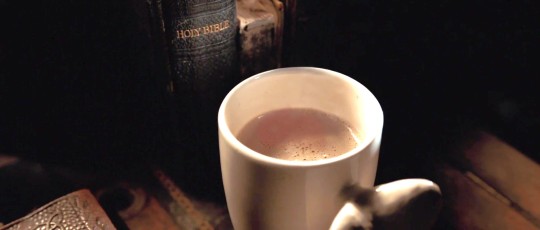
In S2, we see no less than five bibles on his desk alone and more around the bookshop.

The first one is on the left, right under the little "For the Young: Hymns for Church and Home, with Forms of Services" book, which incidentally opens to: "So shall no wicked thing draw near,
To do us harm or cause us fear." (This angel has no shame).
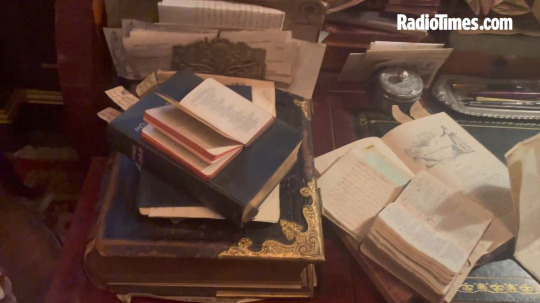
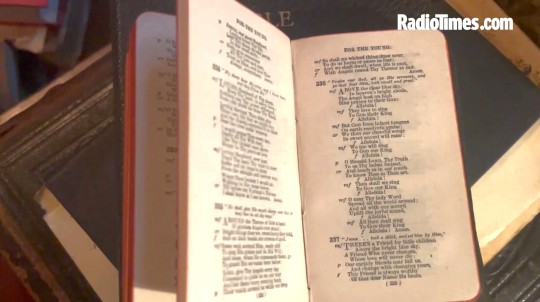
Then there are three more in the desk's middle compartments. One, with a green cover, is on the left slot, right above the tray with pens (this one is a New Testament only).
The other two, both with black covers, are right behind the mug, where the RadioTimes watermark is. They look identical but they could be two volumes of the same edition or two different editions.
We can probably assume one of these is supposed to be the one from S1. The desk in S1 didn't have compartments, it had drawers so there were no books in that area.
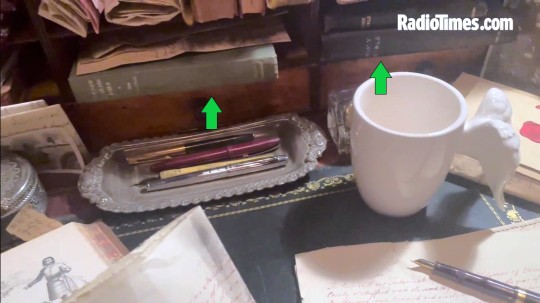
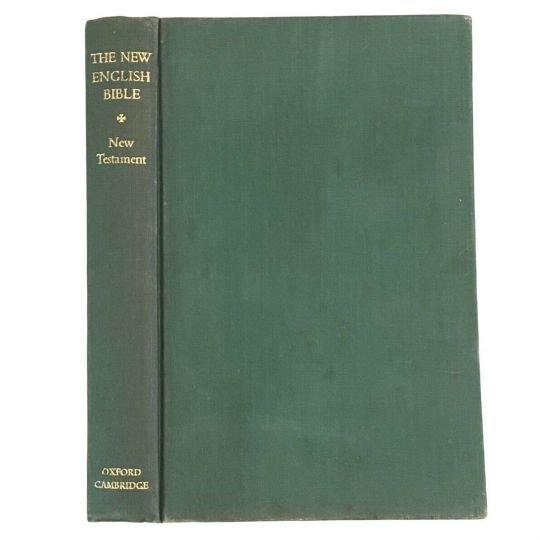
The last one is the on on top of the desk, on the right. This would be the same he used in S1 (although the bible itself is different)

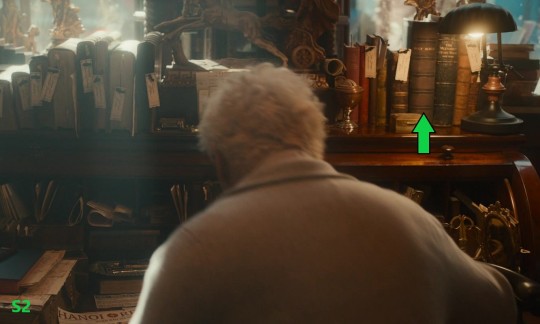
On his right side, sometimes he has an easel where he displays a large book. This is not a bible itself, but an illustrated book of biblical motifs. Sometimes it is closed and sometimes it is open.
He normally has it on the Adam and Eve page (cheeky!) but in Ep 2 he opened it to the Book of Job page instead.


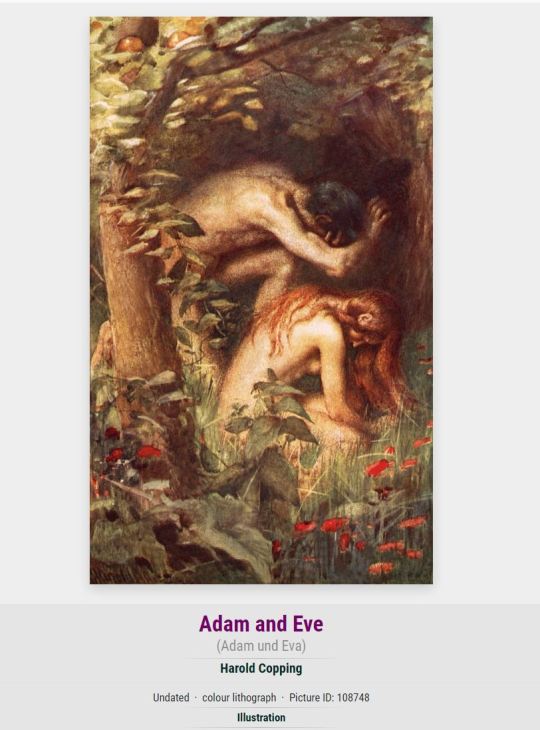
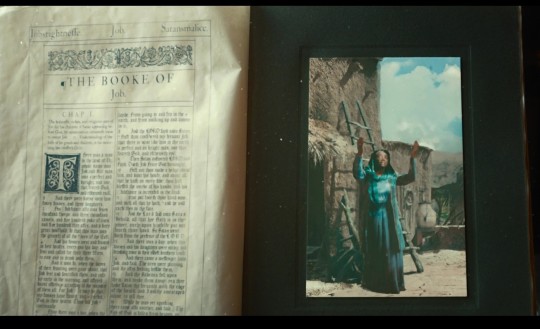
There is yet another one in the shelf that Gabriel Jim is organizing

And there is one more in the first backroom (the one with the computer where he talks with Gabriel and Sandalphon). It is on a little table by the door of the private backroom (the one where he confers with Crowley in)
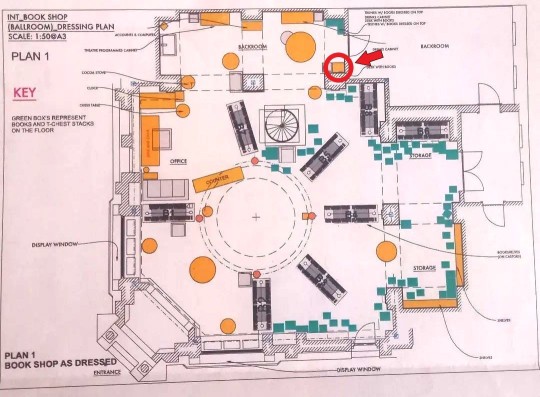

But there is a set of bibles that are even more important to him than any of the other ones. Although the show never mentioned it, the book tells us that in addition to his passion for prophecy books, he also loves and collects misprinted bibles*:
"And he had a complete set of the Infamous Bibles, individually named from errors in typesetting.
These Bibles included the Unrighteous Bible, so called from a printer’s error which caused it to proclaim, in I Corinthians, “Know ye not that the unrighteous shall inherit the Kingdom of God?”; and the Wicked Bible, printed by Barker and Lucas in 1632, in which the word not was omitted from the seventh commandment, making it “Thou shalt commit Adultery.” There were the Discharge Bible, the Treacle Bible, the Standing Fishes Bible, the Charing Cross Bible and the rest. Aziraphale had them all. Even the very rarest, a Bible published in 1651 by the London publishing firm of Bilton and Scaggs."
This collection of bibles is hiding in plain sight and readily on hand. Just ask Jim!

The rest are right there on Aziraphale's desk. The tags are hard to read but I found, from right to left, The Treacle Bible, The Discharge Bible, The Unrighteous Bible, then three that I couldn't decipher,
the Standing Fishes Bible and The Charing Cross Bible. One of those three is supposed to be the Buggre All This Bible, but none of the tags seemed to fit.

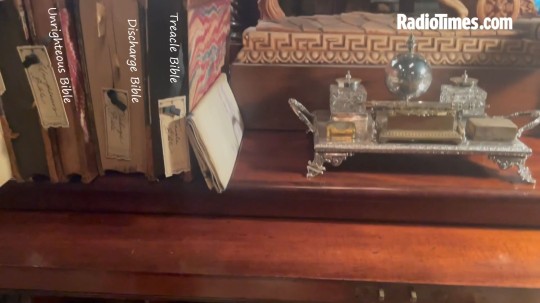
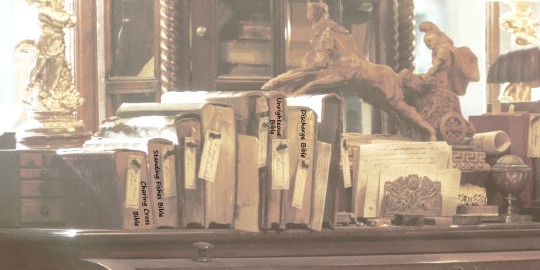
*All the bibles mentioned are real except for the Charing Cross Bible and the Buggre Alle This Bible which in the GO world was printed by Bilton and Scaggs, the publishing company that also printed The Nice and Accurate Prophecies of Agnes Nutter, Witch. I have a whole post about Bilton and Scaggs if interested.
Now, looking back to S1, as part of his restoring the world, Adam replaced Aziraphale's misprinted bibles with Just William books. Let that sink in... Adam moved Aziraphale's bibles from their righteous place. No wonder Crowley realized it right away. These are Aziraphale's bibles for Go- for Sat- for Somebody's sake!

Fortunately by S2 everything was back to normal.
#good omens#good omens 2#good omens book#aziraphale#wicked bible#buggre all this bible#treacle bible#discharge bible#unrighteous bible#standing fishes bible#charing cross bible#adam young#is a cheeky scoundrel#and we love him for it
133 notes
·
View notes
Photo

Battle of Naseby
The Battle of Naseby in Northamptonshire on 14 June 1645 was one of the most important battles of the English Civil Wars (1642-1651). The Royalists, led in person by King Charles, were soundly defeated by the Parliamentarians' numerically superior New Model Army. Naseby was not the end of the war, but the destruction of the king's infantry meant a Parliamentary victory was now inevitable.
The Civil War So Far
King Charles I of England (r. 1625-1649) had clashed with Parliament, particularly over money and religious reforms for years, and, finally, a civil war broke out in 1642. The 'Roundheads' (Parliamentarians) and 'Cavaliers' (Royalists) met in over 600 battles and sieges over the duration of the conflict. From the start, London, the southeast, and the Royal Navy were in the Roundheads' hands while the king controlled the western and northern parts of England.
1644 did not go well for the Royalists. A heavy defeat at the Battle of Marston Moor near York on 2 July 1644 was followed by the loss of York later the same month. The Parliamentarians now controlled the entire north of England except for a few isolated castles, and they had found themselves a gifted new cavalry commander, one Oliver Cromwell (1599-1658). The king still controlled the southwest, and the Roundheads lost the chance to inflict perhaps a final defeat on their opponents at the indecisive Second Battle of Newbury on 27 October 1644. The lack of unity amongst the Roundhead commanders led to a shake-up of Parliament's army and the creation of a new professional force with a new command structure. This was the New Model Army; its overall leader was Sir Thomas Fairfax (1612-1671) with Cromwell as his second-in-command.
In the second week of May 1645, Charles led an army to relieve the siege of Chester. Thomas Fairfax took the opportunity to lead the New Model Army to besiege Oxford, then the Royalist capital and now underdefended. At the end of May, the Royalist army besieged Leicester, hoping to divert Parliamentarian forces from Oxford to the south. Leicester was captured on 31 May, and Fairfax did indeed respond by marching his army northwards. King Charles then made the fatal error of dividing his forces. Two Royalist cavalry groups left, one for the southwest and the other for the north of England, leaving Fairfax with a vastly superior force if he could find the king before he, too, departed. The king did not mobilise in time, spurning a last chance on the evening of 13 June to leave Northamptonshire and fight another day. On Saturday 14 June, the two armies, each occupying a low ridge, faced each other across a wide stretch of relatively open field country just to the north of the village of Naseby with its useful landmark of a windmill.
Continue reading...
39 notes
·
View notes
Text
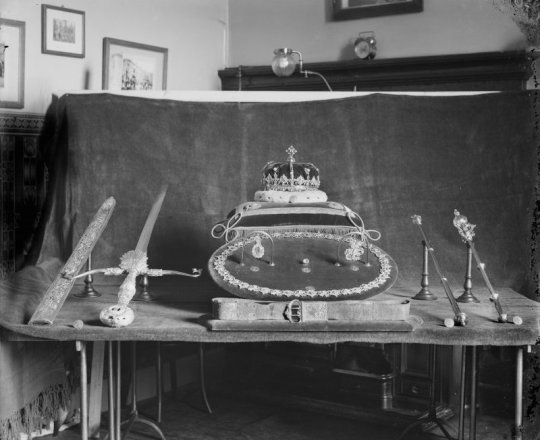


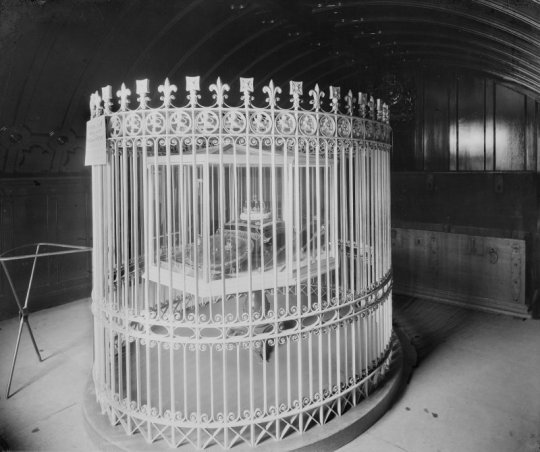
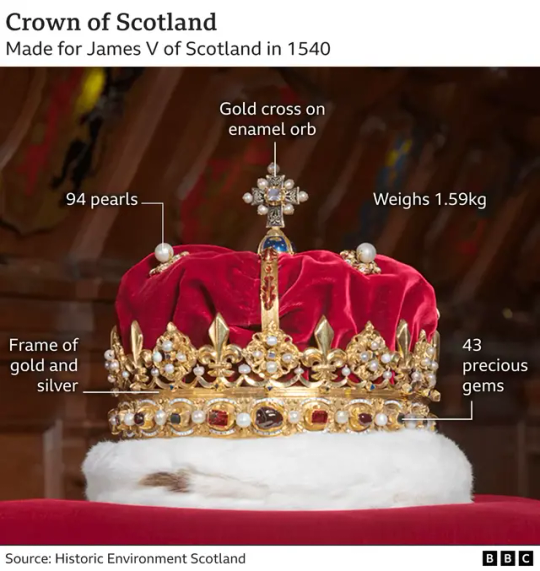

On 26th May 1819, the Honours went on public display in the Crown Room in Edinburgh Castle.
The ‘Honours’, our Crown Jewels, were first used together at the coronation of the nine-month-old Mary, Queen of Scots in 1543, the Crown almost certainly dates from before 1540 when it was remodelled by order of James V. It was last worn at the coronation of Charles II at Scone in 1651, the last time a monarch was crowned in Scotland.
Made of solid silver, the Sceptre is surmounted with three figures supporting a crystal globe, a cut and polished rock crystal, with a Scottish pearl on top. A gift from the Pope, possibly given by Innocent Vlll to James IV in 1494, again it was remodelled by James V who even added his initials to the sceptre, the Stewarts were a vain lot.
The Sword of State was presented to James IV in 1507 by Pope Julius II and has a blade a metre long.
Following the Treaty of Union in 1707, the ancient Honours were not seen for a century. Rumours circulated that the English had removed them to London. However Sir Walter Scott asked for permission to seek them out in in 1818. And as he suspected they were found in a chest hidden away.
They have remained on secure display ever since, except for the duration of World War II.
The Honours have since been joined by other royal regalia and jewels of a personal nature – the Wand (found in the Chest in 1818), the Stewart Jewels (presented by William IV in 1830) and the Lorne Jewels (bequeathed by Princess Louise in 1939) – and by the Stone of Destiny (see separate Statement), which was returned from Westminster Abbey in 1996 after it as stolen by Edward I (Longshanks) Scotland ove700 years before.
Below is a lengthy rundown of the Honours as marked down in history, please note though that the earliest dates are only noted in history some of the original Honours were lost by the English.
574: First reference to a royal sceptre, by Cumméne ‘the White’, seventh abbot of Iona, in connection with the inauguration by St Columba of Aédán mac Gabhráin as king of the Scots of Dál Riata.
1097: King Edgar is depicted on his seal wearing a crown, and holding a sceptre and sword.
1157: David I is depicted in a posthumous charter holding an orb in place of a sceptre.
1182: William I ‘the Lion’ is presented with a golden rose by Pope Lucius II.
1296: Edward I of England strips John I (Balliol) of his crown, sceptre and sword and takes them, together with the Stone of Destiny, to England, where they are subsequently lost or destroyed.
1306: Robert I (Bruce) is enthroned at Scone with a new circlet of gold.
1329: Pope John XXII formally recognises the right of kings of Scots to be formally crowned and anointed, hitherto denied them on account of English opposition.
1331: David II, Robert I’s heir, is formally crowned and anointed at Scone.
1484: Coin evidence (a silver groat) indicates that the crown, hitherto a simple open circlet, has by now become an ‘imperial’ crown (ie, closed with arches).
1486: James III is presented with a golden rose by Pope Innocent IV.
1491: James IV is presented with a golden rose by Pope Innocent VIII.
1494: Tradition has it that the Sceptre was presented to James IV by Pope Alexander VI. However, it is possible that the Sceptre was presented with the golden rose in 1491.
1503: James IV is depicted in the Book of Hours , made to commemorate his marriage, wearing an ‘imperial’ crown. Also, first mention of a crown bonnet.
1507: The Sword of State is presented to James IV by Pope Julius II. A consecrated, or blessed, hat is presented at the same time.
1532: The bonnet is renewed and the crown repaired by Thomas Wood, goldsmith.
1536: The Sceptre is lengthened and embellished for James V by Adam Leys, an Edinburgh goldsmith, perhaps in preparation for his first marriage, to Princess Madeleine de Valois. This enhancement is formally acknowledged when the Crest above the Royal Arms is amended, the Sceptre replacing the Saltire in the lion’s left paw.
1539, the crown is refashioned to its present form for James V by John Mosman, Edinburgh goldsmith. James wears it for the first time at the coronation of his second wife, Mary of Guise, in Holyrood Abbey. The purple velvet bonnet, made by Thomas Arthur, has not survived, but its four delicate ornaments have.
1543: Mary Queen of Scots is crowned in Stirling Castle, the first sovereign to be enthroned with all three Honours. 1
560: Queen Mary receives a golden rose from Pope Pius IV. 1567: James VI is crowned with the Honours in the Kirk of the Holy Rude, Stirling.
1571–73: Substitute Honours are used at sittings of Parliament, because Edinburgh Castle is in the hands of the supporters of the exiled Queen Mary.
1615–16: The Crown Room is created, part of the wholesale remodelling of the Palace in preparation for James VI’s ‘hamecoming’ in 1617. The present Crown Chest is very probably also made at this date.
1633: Charles I is crowned in Holyrood Abbey with the Honours
1638–39: The Honours are taken to Dalkeith Castle for safe-keeping during the conflict between Charles I and those supporting the National Covenant.
1650: The Honours are removed from the castle, possibly to Stirling Castle, for safe-keeping, prior to Oliver Cromwell besieging the castle.
1651: Charles II is crowned with the Honours at Scone. Following the ceremony, the Honours, unable to be brought back to Edinburgh Castle, are taken to mighty Dunnottar Castle, Kincardineshire, seat of the Earl Marischal.
1652–60: The Honours are smuggled out of Dunnottar and buried under the floor of nearby Kinneff Kirk. On Charles II’s return to the throne, the Honours are returned to Edinburgh Castle: all except the Sword belt and Crown cushion.
1687: James VII has the crown bonnet changed from purple to red.
1707: Following the adjourning of Parliament after the passing of the Act of nion.
1790: The Sword Belt is discovered hidden in a wall at Barras, near Dunnottar Castle, by Sir David Ogilvy.
1794: Lieutenant-Governor Major Drummond briefly opens the Crown Room in search of old Parliamentary records but, because he lacks the necessary royal warrant, does not break open the Crown Chest.
1818: Walter Scott and others, with a royal warrant from the Prince Regent, officially break into the Crown Room, break open the Crown Chest and there rediscover the Honours, together with a wand, or baton of office. A second royal warrant appoints the Commissioners for the Keeping of the Regalia (Keeper of the Great Seal, Keeper of the Privy Seal, His Majesty’s Advocate, the Lord Clerk Register and the Lord Justice Clerk). Scott’s friend Adam Ferguson is appointed Keeper of the Regalia, with a ‘grace and favour’ flat above the Crown Room.
1819: The public are invited to inspect the Honours in the Crown Room, on payment of an admission fee.
1822: George IV (the former Prince Regent) formally visits Scotland, and the Honours are taken to the Palace of Holyroodhouse for the duration of his stay.
1830: The Stewart Jewels, bequeathed to George III in 1807 by Prince Henry, Cardinal York, the last Stuart claimant to the throne of Great Britain, are entrusted by William IV into the safe-keeping of the Keeper of the Regalia for display in the Crown Room.
1837: The Turkish Ambassador is denied entry to the Crown Room because he does not have an admission ticket!
1842: The Honours are temporarily removed to an adjacent room so that they may be better viewed by Queen Victoria and Prince Albert.
1848: The present panelling is installed in the Crown Room by the Edinburgh firm of Charles Trotter, cabinetmakers and joiners.
1871: The Honours are redisplayed behind a cage of ornamental bars, for their better security.
1892: The Sword Belt is returned to the Crown Room from Barras Castle, Kincardineshire, by Rev. Samuel Ogilvy Baker, a descendant of Sir David Ogilvy.
1905: The old Crown Cushion is presented to the State by Sir Patrick Keith Murray, who states that it had been retained at Dunnottar by his ancestor, Sir William Keith, 9th Earl Marischal, after the Honours had been smuggled out in 1652
1911: The Sword is taken to St Giles’ Cathedral for the official opening of the Thistle Chapel. Gyp, the Crown Room dog, dies and is buried in the Dog Cemetery below St Margaret’s Chapel.
1939: Princess Louise, Queen Victoria’s fourth daughter, bequeaths the Lorne Jewels, presented to her by Clan Campbell on the occasion of her marriage to the Marquis of Lorne in 1871, to the Scottish nation, and they are added to the display in the Crown Room. Shortly thereafter (1 September), the Crown Jewels are taken down to the basement of the Palace to protect them from aerial bombardment by German planes.
1942: The Honours are secretly taken out of the basement and buried in David’s Tower, where they remain for the duration of WWII.
1953: The Honours are presented to Her Majesty Queen Elizabeth at the National Service of Thanksgiving in St Giles’ Cathedral that follows the Coronation in Westminster Abbey.
1971: The Sword of State is used for the first time at the ceremonial installation of a Knight of the Most Ancient and Most Noble Order of the Thistle, Scotland’s premier Order of Chivalry, held in the Thistle Chapel, in St Giles’ Cathedral.
1980s: The post of Warden of Regalia is abolished. 1
987: The Sword of State is used alone for the final time, in St Giles’ Cathedral for the tercentenary anniversary celebrations of the Order of the Thistle. Thereafter, in view of its parlous condition, its ceremonial role is restricted to National Services of Thanksgiving
1993: Her Majesty Queen Elizabeth formally opens the Honours of the Kingdom exhibition, including the extensively refurbished Crown Room and redisplayed Honours. The present Crown Cushion is made specially for the occasion. The Crown Chest is relocated from the Crown Room to an adjacent exhibition space and displayed alongside one of the original padlocks, broken in 1818.
1999: The Crown is formally taken to the State Opening of the Scottish Parliament, the first in the modern era.
2022; The Crown of Scotland was placed on Elizabeth II's coffin at a service in St Giles' Cathedral.
2023; The Honours of Scotland were presented to King Charles III in a ceremony held in St Giles' Cathedral. The ceremony was formally described as a National Service of Thanksgiving and Dedication to mark the coronation of King Charles III.
36 notes
·
View notes
Text
A Huguenot, on St. Bartholomew's Day, Refusing to Shield Himself from Danger by Wearing the Roman Catholic Badge (1851–52) is the full, exhibited title of a painting by John Everett Millais, and was produced at the height of his Pre-Raphaelite period. It was accompanied, at the Royal Academy of Arts in London in 1852, with a long quote reading: "When the clock of the Palais de Justice shall sound upon the great bell, at daybreak, then each good Catholic must bind a strip of white linen round his arm, and place a fair white cross in his cap. —The order of the Duke of Guise."
It depicts a pair of young lovers and is given a dramatic twist because the woman, who is Catholic, is attempting to get her beloved, who is Protestant, to wear the white armband declaring allegiance to Catholicism. The young man firmly pulls off the armband at the same time that he gently embraces his lover, and stares into her pleading eyes. The incident refers to the St. Bartholomew's Day massacre on August 24, 1572, when around 3,000 French Protestants (Huguenots) were murdered in Paris, with around 20,000 massacred across the rest of France. A small number of Protestants escaped from the city through subterfuge by wearing white armbands.
Millais had initially planned simply to depict lovers in a less dire predicament, but supposedly had been persuaded by his Pre-Raphaelite colleague William Holman Hunt that the subject was too trite. After seeing Giacomo Meyerbeer's opera Les Huguenots of 1836 at Covent Garden, which tells the story of the massacre, Millais adapted the painting to refer to the event. In the opera, Valentine attempts unsuccessfully to get her lover Raoul to wear the armband. The choice of a pro-Protestant subject was also significant because the Pre-Raphaelites had previously been attacked for their alleged sympathies to the Oxford Movement and to Catholicism.
Millais painted the majority of the background near Ewell in Surrey in the late summer and autumn of 1851, while he and Hunt were living at Worcester Park Farm. It was from a brick wall adjoining an orchard. Some of the flowers depicted in the scene may have been chosen because of the contemporary interest in the so-called language of flowers. The blue Canterbury Bells at the left, for example, can stand for faith and constancy. Returning to London after the weather turned too cold to work out-of-doors in November, he painted in the figures: the face of the man was from that of Millais's family friend Arthur Lemprière, and the woman was posed for by Anne Ryan.
The painting was exhibited with Ophelia and his portrait of Mrs. Coventry Patmore (Fitzwilliam Museum, Cambridge) at the Royal Academy of Arts in 1852, and helped to change attitudes towards the Pre-Raphaelites. Tom Taylor wrote an extremely positive review in Punch. It was produced as a reproductive print by the dealer D. White and engraved in mezzotint by Thomas Oldham Barlow in 1856. This became Millais's first major popular success in this medium, and the artist went on to produce a number of other paintings on similar subjects to serve a growing middle class market for engravings. These include The Order of Release, 1746 (Tate, London), The Proscribed Royalist, 1651 (Lord Lloyd-Webber Collection), and The Black Brunswicker (Lady Lever Art Gallery, Port Sunlight). All were successfully engraved.
There are smaller watercolor versions of the picture in The Higgins Art Gallery, Bedford, the Fogg Art Museum, Harvard University, and a reduced oil replica in the Lord Lloyd-Webber Collection, all by Millais.
67 notes
·
View notes
Text



















Nun Appleton House
Hi guys!!
I'm sharing Nun Appleton House. This is the 13th building for my English Collection.
I added aa garden, which is my own creation and not the original of the house.
History of the house: The hall itself is built of reddish-orange brick with ashlar dressings and a Welsh slate roof in three storeys to a rectangular floor plan. It is grade II listed and now stands in some 200 ha. of parkland.
The estate was acquired by The 1st Lord Fairfax of Cameron, a Yorkshireman with a Scottish peerage, following the Dissolution of the Monasteries, from whom it descended to The 3rd Lord Fairfax of Cameron, the well-known English Civil War commander, who built the present hall in the late 1600s.
In his time (1651) the estate was the inspiration for Andrew Marvell's Upon Appleton House, a significant country house poem. Marvell was tutor to Thomas Fairfax's daughter, Mary. After the death of Mary (who had married The 2nd Duke of Buckingham) in 1704 the estate was eventually sold in 1711 to Alderman William Milner of Leeds who carried out many alterations to the house.
His son William was created the 1st Milner Baronet, of Nun Appleton Hall in the County of York, in 1717 and was later Member of Parliament for York. The estate then descended in the Milner family until 1875, when the estate's owner, Sir William Mordaunt Milner, 6th Baronet, was more interested in gambling than looking after it.
By 1877 it had been leased to William Beckett-Denison, a wealthy Leeds banker. After the death of Sir William Milner in Cairo in 1881, his brother Frederick inherited the estate and in 1882 married Adeline, eldest daughter of William Beckett-Denison. After William Beckett's gruesome death in 1890, the Hall and estate were sold to Angus Holden, a sometime M.P. (later created Baron Holden), a woollen manufacturer from Bradford, whose ownership was somewhat brief as he died in 1912.
The hall was now empty and many of the tenanted farms were sold. The estate was put up for auction in 1914 and again in 1917 and eventually acquired by a private company which felled many of the trees but by 1919 had gone into liquidation. It was bought in 1920 by Sir Benjamin Dawson, 1st Baronet, another Bradford textile manufacturer, who was High Sheriff of Yorkshire for 1951–52. During the Second World War the hall was taken over by the London Maternity Hospital.
When the stable block accidentally burnt down it was afterwards refurbished as a theatre and made available to the local community.
The property was bought from the last occupant, Sir Benjamin's daughter Joan Dawson, for £1.2 million in the 1980s by Humphrey Smith of the Samuel Smith brewing family. The house is now fenced off, empty, unused and deteriorating.
Video below check it out
For more info: https://www.facebook.com/story.php/?story_fbid=928431841986992&id=100044605540042&_rdr
----------------------------------------------------------------------------------------------------------------------
This house fits a 50x50 lot (I think if you lose the gaden and terrace it can fit a 50x40 too)
I furnished just the principal rooms, so you get an idea. The rest is unfurnished so you create the interiors to your taste!
Hope you like it.
You will need the usual CC I use:
all Felixandre cc
all The Jim,
SYB
Anachrosims
Regal Sims
King Falcon railing
The Golden Sanctuary
Cliffou
Dndr recolors
Harrie cc
Tuds
Lili's palace cc
Please enjoy, comment if you like it and share pictures with me if you use my creations!
Free to download blueprint: https://www.patreon.com/user?u=75230453
#sims 4 architecture#sims 4 build#sims4#sims 4 screenshots#sims4play#sims 4 historical#sims4building#sims4palace#ts4#ts4 simblr#ts4 gameplay#the sims community#sims 4#the sims 4#sims4 play#sims 4 royalty#sims 4 cc#sims 4 gameplay#thesims4#sims 4 legacy#sims4 build
37 notes
·
View notes
Text

Cornelis de Vos, Dutch/Flemish c.1584–1651, Mother and child, 1624, oil on wood panel, 123.4 x 92.5 cm, National Gallery of Victoria, Melbourne. (detail)

Rembrandt, Portrait of Margaretha de Geer, 1661, 75.3 × 63.8 cm, National Gallery London. (detail),
12 notes
·
View notes
Photo
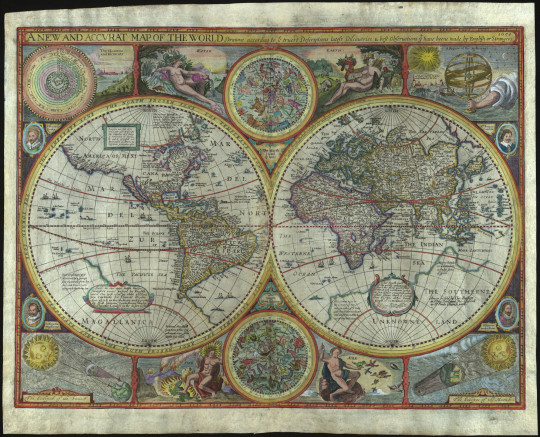
John Speed (1551/52-1629). A New and Accurat Map of the World Drawne according to ye truest Descriptions lastest Discoveries & best observations yt have beene made by English or Strangers. London, 1651.
This map first appeared in A Prospect of the Most Famous Parts of the World, published by George Humble in 1627. George Humble had previously printed Speed’s The Theatre of the Empire of Great Britain, a pioneering work that mapped English counties and maps. The Prospect was a very “English” atlas: it is the first world atlas by an Englishman (though not the first world atlas to be published in England) and does not appear to have circulated much outside of England. It is unclear just how involved Speed was in its production, as he had gone blind in 1625 and the Prospect’s organization in general is not as meticulous as one might otherwise expect from Speed. The map was engraved, possibly by Abraham Goos (fl. 1614-1643), and then hand-colored for sale.
(see more: The World: Science and Art · Places in the World: Treasures from the Venable Collection · Special Collections and Archives)
#mapMonday#maps#map#world map#historical maps#bookhistory#rare books#special collections#mizzou#university of missouri#libraries#john henry#columbia mo
78 notes
·
View notes
Text
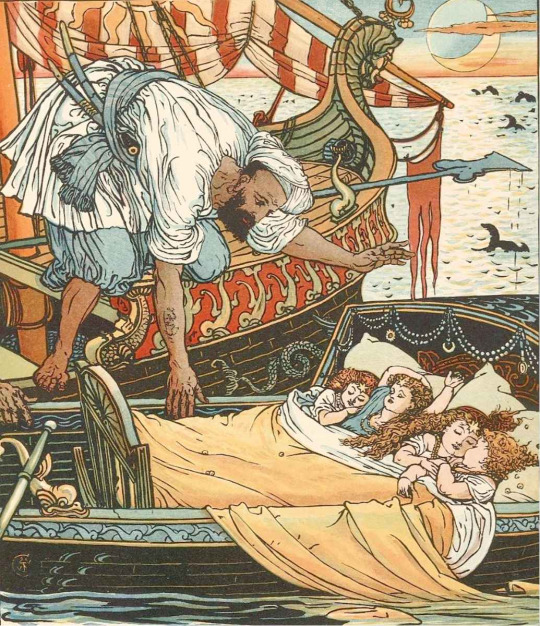
Illustrations: Walter Crane (British, 1845-1915) • Engraved and printed by Edmund Evans
The children of Queen Blondine and sister Brunette picked up by a Corsair after seven days at sea, from the fairy tale Princess Belle-Etoile (Beautiful Star Princess), a fairy tale written by Madame d'Aulnoy (French, 1650/1651-1705)
Published by George Routledge & Sons, London • 1875
#illustration#art#book illustration#french fairytale#walter crane#british illustrator#english artist#french author#princess belle-etoile#engraving#vintage books#old fairy tales#sassafras & moonshine blog
17 notes
·
View notes
Text
Smeyer is obsessed with teenagers fr
So, after seeing this post by @the-most-pathetic-edge-marquis, I ended up going through the Illustrated Guide a bit more thoroughly to look at the ages of all the Twilight Vamps when they were turned. It's a bit creepy honestly, and the woman the woman is for sure not trying to hide her knks with these mostly teenagers.
And i dunno, quick fic info sheet if it helps anyone 🤷♀️
Edward – 17
Bella – 18
Alice – 19
Jasper – 19
Emmett – 20
Rosalie – 18
Esme – 26
Carlisle – ‘Approximately’ 23. I would like to take the time to mention that people did know the date when he was alive, so the fact Carlisle canonly doesn’t know his exact age is ridiculous. AND ALSO the London sewers had not been created at this time, so how was he killed by sewer vamps smeyer!?
Victoria – Born in the 1550s, transformed late 1560s, at around 18.
James – Born around 1780, turned around 1805, making him about 25. 🚩
Laurent – DOB 1700s, turned around 1740s at about 40.
Eleazar - DOB 1700s. Transformed in 1700s.
Carmen – DOB 1700s. Transformed in 1700s. Lazy writing. 🙄
Irina – DOB 1000s. Transformed 1000s.
Kate (full name Katrina I just learnt) - DOB 1000s. Transformed 1000s.
Tanya - DOB 1000s. Transformed 1000s. We get it smeyer, you can't be bothered...
Garrett – DOB mid 1700’s. Transformed around 1780. Won’t lie. I read that wrong at first and thought he was 80 for a sec…
There is not really any info on the girl’s mother, Sasha, that isn’t in the books, but the immortal child, Vasilii, she created was 3.
Aro – Ok, so the guide says ‘Born around 1300 BC’ and ‘Transformed around 1260 BC’ But at the bottom of the same page says he was ‘transformed in his mid-20’s’ so ????
Marcus – ‘Transformed before he was 20’ But at the top of the page has his DOB as ‘Around 1350 B.C’ and his date of transformation ‘Unknown’… Like girl can you not do simple math!?
Caius – Late 40’s. But same as Marcus, has a DOB but and unknown date for his transformation.
Sulpicia – Described as a ‘lovely young orphan’ 😶
Didyme – No age, but is younger than Aro.
Athenodora – No real description, was already turned when she met Caius.
Alec – 12 or 13
Jane – 12 or 13
Demetri – DOB around 1000 AD. Transformation after 1000 AD. Thanks smeyer, very helpful.
Felix – Mans got no birthdays 😔
Heidi – DOB before 1550. Transformed before 1550. Yup, ‘before’ on both dates. How can this woman give everyone an exact height, but lose interest with the birthdays? You size-kink is showing smeyer.
Renata – Around 20. Why does this random character who doesn’t show up until the end have an age, but my man felix got nothin!?
Chelsea – DOB before 1100AD. Transformation after 1100AD. Girl just pick a number 😤
Afton – No dates
Corin – No dates
Santiago – No dates
Amun – Born before 2500 BC, but no indication of age.
Kebi - Born before 2500 BC, but no indication of age.
Benjamin – Born sometime between 1790 – 1800. Transformed sometime between 1805 – 1820 at age 15. HE IS 15!?!?!?! 👶
Tia – As a human, she was 3 years younger than Benjamin. But she was turned 5 years after him when she was 17. They are also distantly related. Because of course they are 🥴
Liam – Born around 1615, turned around 1651, making him 36.
Siobhan – Born around 1490, turned around 1510, at approximately 20.
Maggie – Born 1832, turned 1847, also 15! 👶
Maria – No DOB, but transformed 1800’s or earlier, at 19
Lucy – No dates.
Nettie – No dates
Stefan – Unknown DOB, turned before 1000 BC.
Vladimir - Unknown DOB, turned before 1000 BC. Also, smeyer did enough research to know Romania was not yet a country when these two were turned, but didn’t know about the London sewer system. My girl, get 👏 it 👏together👏
Alistair – Born around 1300, transformed around 1320, so is around 20
Peter – Born between 1860 and 1920. Turn between 1860 and 1920. Just pick a number woman.
Charlotte – Born between 1920 and 1925. Turned around 1938, at 18. Smeyer, just say she was born in 1920, why is it so hard for you to do that. The amount of times I’ve written ‘around’ is starting to piss me off. JUST DECIDE. IT IS LITTERALLY UP TO YOU. 😤😤😤
Kachiri – No dates
Senna – No dates
Zafrina – No dates. Rude. We know why. 🙃
#twilight#edward cullen#Bella Swan#alice cullen#jasper hale#jasper whitlock#Rosalie Hale#Emmett Cullen#Emmett McCarty#esme cullen#carlisle cullen#aro volturi#Caius Volturi#Marcus Volturi#demetri volturi#felix volturi#jane volturi#alec volturi#Heidi Volturi#maria twilight#victoria#james#laurent#tanya denali#Irina Denali#kate denali#smeyer
60 notes
·
View notes
Text
fun details i noticed while watching good omens!
when aziraphale lists the dates that he did the apology dance (1650, 1793, and 1941) not one but TWO of these years are familiar. while i have a few leads on what 1650 would entail, the other two are very straightforward
1793. you may recognize the date as the same year that aziraphale found himself locked up in the bastille. so clearly this indicates that not only did aziraphale buy crowley some crepes, he also apologized for the bastille thing. with dance.
and 1941 is the year that aziraphale was rescued by crowley from a church in london when he was about to be killed by nazis. BUT i doubt the apology was for that because... guess what happened before 1941? i believe he is apologizing for the argument he had with crowley over the matter of holy water in saint james' park in 1862!
now i'm going to put the few leads i have on 1650 down here, though what we have involves a higher level of searching . feel free to stop reading now and i'll add a cut
when we look in the script book, and the actual book, there are only a few things i can find in the era (for reference, i am considering only things that happened in 1600, though it could theoretically be anything before this point considering. i just don't want to take forever)
the closest scene to this date is in 1601, when aziraphale and crowley meet in the globe theater to watch hamlet. this scene, while loads of fun, i doubt to be really entirely related.
there are multiple things that happen in the 1650s but, later than 1650 itself. agnes nutter's book of prophecies was published in 1655 and agnes nutter herself was killed in 1656. these are after the date of 1650 but it is interesting that this dance was done during a time that she was alive
1654 was when the book annales veteris et novi testaments was published, containing the date of when the universe was created down to the second. also interesting. also unhelpful
1651 was the year that the buggre alle this bible was published. close but still after. sorry
in 1653, bilton and scaggs bought one of shakespeare's lost folios and then proceeded to lose it again. still too late.
1631 was the year the wicked bible was published (known for featuring the quote "thou shalt commit adultery")
and that's all i can really find. so probably a dead end here i am sorry to say! so uhhh sorry about that (should i do the dance?) but 2/3 is good too
#good omens liveblog#technically i researched this because i combed through my copy of the script and also the book itself#so not really all that livebloggy#good omens spoilers#good omens#do i tag this with anything else#good omens season 2#listen i thought the years sounded familiar. AND I WAS RIGHT
15 notes
·
View notes
Text

Trayne
Ein Zug der Imagination, der Vorstellungs- oder Einbildungskraft, der Bildlichkeit oder Bildgebung.
1 note
·
View note
Text
Bilton and Scaggs
Back when I was working in the map of Soho, I got to Bilton and Scaggs Hats and Caps. There is so much to say about this shop and its history, and it is so interesting that it warrants its own post, so here we are
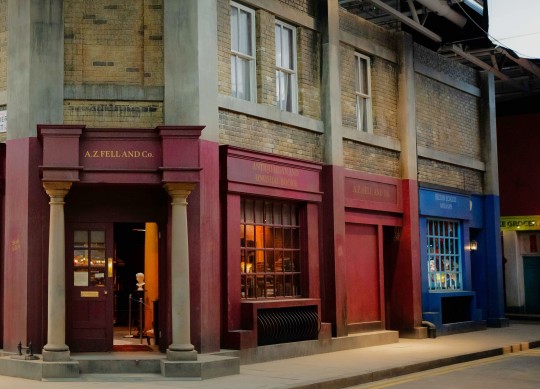
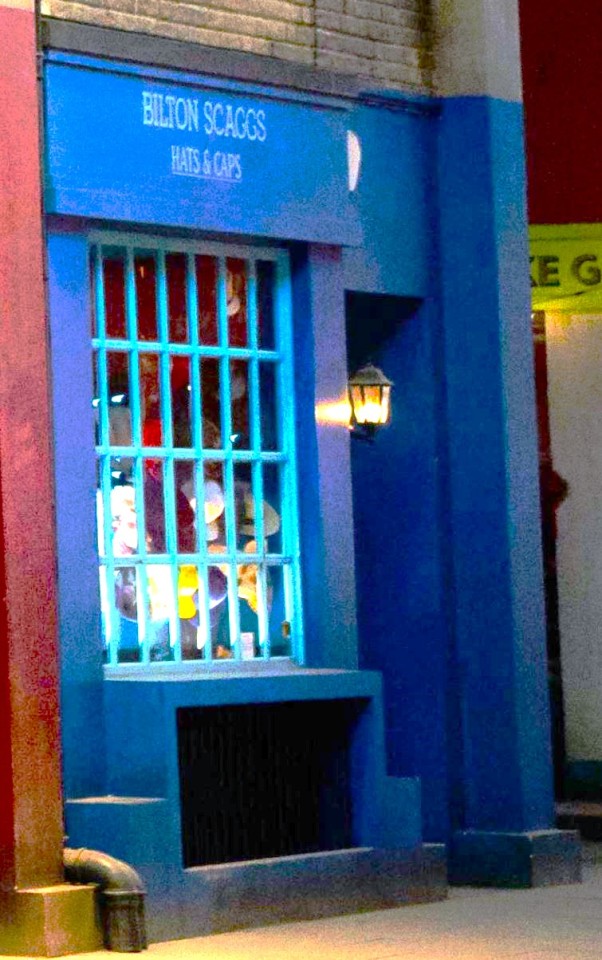
Bilton and Scaggs Publishers was a London publishing firm in the 1600's, we don't really know when it was established though. They were not one of the eight great publishers of London, but they were doing well enough, after all, it was able to survive its three major publishing disasters (which occurred in rapid succession).
Alas, it looks like Bilton and Scaggs, publishers went out of business somewhere in the 1890's and the milliner who set up shop there, kept the name. Nowadays, only Aziraphale knows the full story.
What follows are details of their disasters. They are quite funny, unless you are Master Bilton or Master Scaggs of course :P
The first one was in 1651; when they accidentally printed the so called Buggre Alle This Bible. This very rare misprinted Bible had a few verses added to Genesis and a variation in Ezekiel. Of course our angel owns one copy.
Genesis chapter 3 normally has 24 verses where the last one goes like this: "24. So he drove out the man; and he placed at the east of the garden of Eden Cherubims, and a flaming sword which turned every way, to keep the way of the tree of life." The three additional ones go like this:
25. And the Lord spake unto the Angel that guarded the eastern gate, saying Where is the flaming sword which was given unto thee?
26. And the Angel said, I had it here only a moment ago, I must have put it down some where, forget my own head next.
27. And the Lord did not ask him again.
"It appears that these verses were inserted during the proof stage. In those days it was common practice for printers to hang proof sheets to the wooden beams outside their shops, for the edification of the populace and some free proofreading, and since the whole print run was subsequently burned anyway, no one bothered to take up this matter with the nice Mr. A. Ziraphale, who ran the bookshop two doors along and was always so helpful with the translations, and whose handwriting was instantly recognizable."
The other issue with this Bible was a little change in Ezekiel 48:5 and it is the change that gives the Bible its name:
2. And bye the border of Dan, fromme the east side to the west side, a portion for Afher.
3. And bye the border of Afher, fromme the east side even untoe the west side, a portion for Naphtali.
4. And bye the border of Naphtali, from the east side untoe the west side, a portion for Manaffeh.
5. Buggre Alle this for a Larke. I amme sick to mye Hart of typefettinge. Master Biltonn if no Gentelmann, and Master Scagges noe more than a tighte fisted Southwarke Knobbefticke. I telle you, onne a daye laike thif Ennywone with half an oz. of Sense shoulde bee oute in the Sunneshain, ane nott Stucke here alle the liuelong daie inn thif mowldey olde By-Our-Lady Workefhoppe. @ “Æ@;!
6. And bye the border of Ephraim, from the east fide even untoe the west fide, a portion for Reuben.
What we can conclude from here is that Aziraphale owned a bookshop in the 1650's that was in the same block as Bilton and Scaggs Publishers.
From the deleted scenes in the script book we know he opened A. Z. Fell & Co. in 1800. But there is nothing saying he couldn't have owned a bookshop with a different name decades or centuries before.
The bookshop tour special feature from the S1 DVD says he's had it for 350 years. Counting from 2020, that would put it at around 1670. But if we generalize to around 2000, that means the shop could have been there in the 1650's. This more or less matches this ask where it is explained that Aziraphale bought the land in 1630 and over the next 60 years (1690ish) he expanded and built the current bookshop.

Sorry for the tangent, back to Bilton and Scaggs.
The second publishing disaster occurred in 1653 when somehow they obtained one of the famed Shakespeare's "Lost Quartos" and subsequently lost it (the three Shakespeare plays never reissued in folio edition and now are totally lost to scholars and playgoers. Their names are "The Comedie of Robin Hoode, or, The Forest of Sherwoode", "The Trapping of the Mouse", and finally "Golde Diggers of 1589."
In S2 Episode 6 we see all three folios inside the box Gabriel brought with him. I am sure if asked directly, Aziraphale will assure you that he has no idea how those pamphlets got into that box. It was completely empty only four days ago!
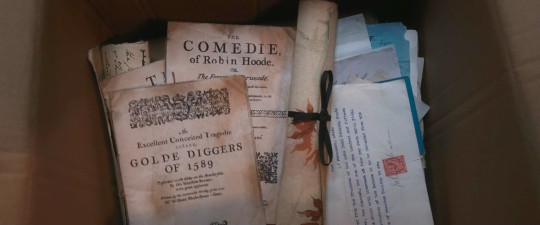
The third and final disaster happened in 1655 and involved a prophecy book that didn't sell a single copy and ended up being the first book remaindered in England: "The Nice and Accurate Prophecies of Agnes Nutter, witch." Not even the sign "Locale Author" attached to the book helped sell it in the author's home town in Lancashire.
At the end the publisher destroyed all the unsold copies. Aziraphale, however, seems to have found the 1655 catalog from Bilton and Scaggs that contained only the 1972 prophecy "Do not buy Betamax."
I do find interesting that although evidently Aziraphale had a close relationship with Master Bilton and Master Scaggs, he still failed to secure a copy of the prophecies. It was printed right there! Next to you! How did that happen? Where were you, Aziraphale??!!
#good omens#good omens 2#good omens book#aziraphale#Mr. A. Ziraphale#a.z. fell & co#bilton and scaggs#buggre alle this bible#shakespeare's lost quartos#the nice and accurate prophecies of agnes nutter
45 notes
·
View notes
Photo

Colonel Blood & the Theft of the Crown Jewels
Colonel Thomas Blood, a known conspirator, made an infamous but unsuccessful attempt to steal the British Crown Jewels from the Tower of London in 1671. Disguised as a clergyman, Blood and his gang swiped the royal regalia from under the nose of their keeper, but they were captured as they made their escape through the capital. Blood was mysteriously pardoned by the king, and the regalia, although a little bashed, was given a much more secure home.
The Tower
Following the execution of Charles I of England (r. 1625-1649) in January 1649 during the English Civil Wars (1642-1651), the monarchy in England was abolished. A consequence of this was the breaking up of the royal regalia, which was sold off or made into coinage. Following the Stuart Restoration of 1660 and the return of the monarchy in the form of Charles II of England (r. 1660-1685), a new set of regalia was required for a new coronation. King Charles' coronation in Westminster Abbey on 23 April 1661 was a splendid affair with pomp, ceremony, and plenty of sparkle. The monarch's crown, sceptre, and orb have been used in coronations ever since.
Naturally, a secure place was required to keep these valuables until they were needed for a new coronation, and the choice was the Tower of London. Kept in the Lower Martin Tower (then called the 'Irish Tower'), the glittering collection was surely beyond the reach of any would-be thief. The reputation of the Tower of London was dark indeed in the public's imagination. Over the centuries, this was where so many traitors and criminals had been tortured. Mysterious royal murders and executions had taken place here. Its very name, simply 'The Tower', conjured up dark images of unspeakable terrors. Surely, no person would dare enter it to commit a crime. Here, if anywhere in the kingdom, the Crown Jewels were safe. Or so the authorities thought. 'Colonel' Thomas Blood had other ideas.
Continue reading...
39 notes
·
View notes
Text



On July 2nd 1644 Scots forces under David Leslie helped in the victory of the Parliamentary forces over the Royalists at the Battle of Marston Moor.
When the Covenanters made an alliance with the English Parliamentarians, Leslie was appointed lieutenant-general, When the Covenanters made an alliance with the English Parliamentarians in 1644, Leslie led a brigade of Scottish horse in support of Cromwell’s Ironsides at Marston Moor on the left wing of the Allied army. His flank attack tipped the scales in Cromwell’s favour in the struggle between the Ironsides and Prince Rupert’s cavaliers, saving a wounded Cromwell in the process.
A year later Leslie would later take his army back into Scotland in pursuit of James Graham, The Marquess of Montrose but by 1646 was back in England, where Charles I surrendered to him, thinking he would be a lot safer in the hands of a Scottish army.
Unfortunately Leslie “sold” him to the English in exchange for wages due to the Covenanter army, the outcome of course was the King was executed, sending shockwaves through Scotland, Charles was the last King of Scots to be born here.
Leslie would go on to support Charles II, but lost to Cromwell’s army at Worcester in September 1651, he was imprisoned at The Tower of London for nine years, his freedom was granted on the restoration of the monarchy in 1660.
The memorial to the battle is in the third pic and in the background is Marston Hill, crowned by the clump of trees known as "Cromwell's plump", reputedly the site of the Parliamentarian and Covenanter headquarters.
9 notes
·
View notes
Text

Vincent and the Doctor: The Doctor and Amy Pond meet Vincent van Gogh... And an ancient, terrifying monster.
The Woman Who Lived: England, 1651. Deadly highwayman 'the Knightmare' and his sidekick come face to face with the Doctor on the dark streets of London.
15 notes
·
View notes